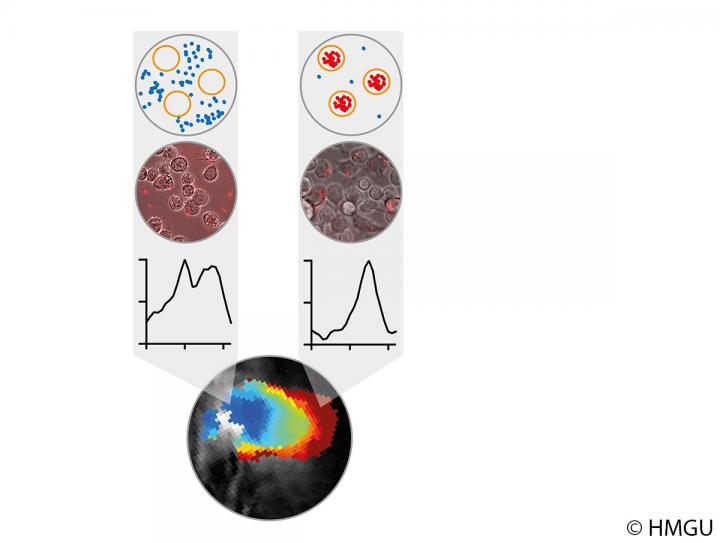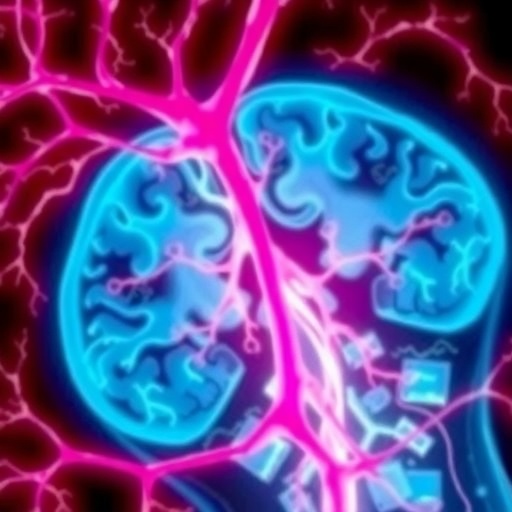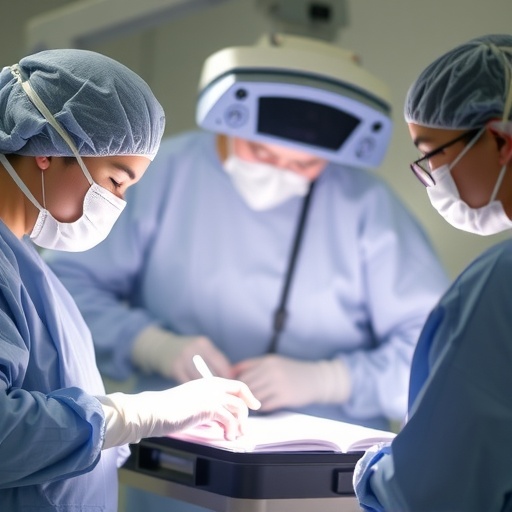
Credit: ©Helmholtz Zentrum München
Cancer presents an ongoing challenge for physicians, particularly in the diagnosis and treatment of the disease. This is, amongst other things, due to tumor heterogeneity. A team of scientists from the Helmholtz Zentrum Muenchen, the Juelich Research Center, the Technical University of Munich and the Heinrich Heine University Duesseldorf has now shown that harmless purple bacteria of the genus Rhodobacter are capable of visualizing aspects of this heterogeneity in the tumors. With the aid of optoacoustic imaging, the researchers used these microorganisms to visualize cells of the immune system, so-called macrophages* (Greek for ‘big eaters’), that also play a role in tumor development. Their research findings have now been published in Nature Communications.
Many cancers form solid tumors. Inside, such tumors reveal major differences at the cellular and molecular level. One of these concerns the localization and activity of macrophages. Although these cells are essential for a healthy immune system, they also play a key role in tumor development. With the aid of photosynthetic bacteria, new optoacoustic techniques, which indicate where such macrophages are present and active, have now been developed.
“We were able to demonstrate that bacteria of the genus Rhodobacter**, which are harmless to humans, are suitable as indirect markers of macrophage presence and activity,” says Dr. Andre C. Stiel, head of the Cell Engineering Group at the Institute of Biological and Medical Imaging (IBMI), Helmholtz Zentrum München. Rhodobacter bacteria produce large quantities of the photosynthetic pigment bacteriochlorophyll a. This pigment enabled the researchers to detect bacteria in a tumor by means of multispectral optoacoustic tomography (MSOT)***.
How does the principle work? Macrophages engulf bacteria as part of their natural scavenging activity, which is known as phagocytosis. This alters the surroundings of the bacteria, their absorption of electromagnetic radiation and, as a result, also the optoacoustic signal. Rhodobacter bacteria thus act like sensors for scientists, providing them with information about the presence and activity of macrophages.
“In further steps, these bacteria will enable novel approaches to non-invasive technologies and so open up entirely new possibilities for innovative diagnostic and therapeutic procedures,” adds Dr. Thomas Drepper, who heads the Bacterial Photobiotechnology Group at Heinrich Heine University Duesseldorf. In future, bacteria may be able to reveal the location of a tumor and also detect increased macrophage activity. Depending on their localization, the macrophages could provide information about unwelcome inflammations or the desired response to immunotherapies, and could ultimately be used to improve treatment strategies.
###
Further Information
*As is known today, tumors harbour specific microenvironments. One of the components of the tumor microenvironment are tumor-associated macrophages. These scavenger cells are part of our immune system, but in the case of a cancerous disease they are involved in unwanted inflammation of the tumor tissue – a process that leads to the further progression of the disease.
**Rhodobacter occurs worldwide in stagnant and flowing water. The bacteria produce different pigments in order to carry out photosynthesis. These include bacteriochlorophyll a, which is suitable for MSOT examinations to localize solid tumors. Rhodobacter cells do not cause infections in humans.
***During a MSOT scan, light is initially converted into sound, then into visual information. Initially, a weak, pulsating laser beam is directed towards the body. When the beam encounters molecules and cells, they heat up minimally and respond with minimal vibrations, which in turn generate acoustic signals. These are then picked up by sensors and converted into images. The way in which the individual cells and molecules react to the laser depends on their optical properties – in this case, for example, on the properties of bacterial pigments.
Original Publication:
Lena Peters et al. (2019): Phototrophic purple bacteria as optoacoustic in vivo reporters of macrophage activity. Nature Communications, DOI: 10.1038/s41467-019-09081-5
As German Research Center for Environmental Health, Helmholtz Zentrum Muenchen pursues the goal of developing personalized medical approaches for the prevention and therapy of major common diseases such as diabetes mellitus and lung diseases. To achieve this, it investigates the interaction of genetics, environmental factors and lifestyle. The Helmholtz Zentrum München has about 2,300 staff members and is headquartered in Neuherberg in the north of Munich. Helmholtz Zentrum München is a member of the Helmholtz Association, a community of 18 scientific-technical and medical-biological research centers with a total of about 37,000 staff members. http://www.
The Institute of Biological and Medical Imaging (IBMI) conducts research into in vivo imaging technologies for the biosciences. It develops systems, theories and methods of imaging and image reconstruction as well as animal models to test new technologies at the biological, preclinical and clinical level. The aim is to provide innovative tools for biomedical laboratories, for diagnosis and for the therapeutic monitoring of human diseases. http://www.
The Technical University of Munich (TUM) is one of Europe’s leading research universities, with around 550 professors, 41,000 students, and 10,000 academic and non-academic staff. Its focus areas are the engineering sciences, natural sciences, life sciences and medicine, combined with economic and social sciences. TUM acts as an entrepreneurial university that promotes talents and creates value for society. In that it profits from having strong partners in science and industry. It is represented worldwide with the TUM Asia campus in Singapore as well as offices in Beijing, Brussels, Cairo, Mumbai, San Francisco, and São Paulo. Nobel Prize winners and inventors such as Rudolf Diesel, Carl von Linde, and Rudolf Mößbauer have done research at TUM. In 2006 and 2012 it won recognition as a German “Excellence University.” In international rankings, TUM regularly places among the best universities in Germany. http://www.
Forschungszentrum Jülich makes a vital contribution to solving major challenges facing society in the fields of information, energy, and bioeconomy. It focuses on the future of information technologies and information processing, complex processes in the human brain, the transformation of the energy system, and a sustainable bioeconomy. Forschungszentrum Jülich develops simulation and data sciences as a key research method and makes use of large, often unique, scientific infrastructures. With some 5,900 employees and about 800 visiting scientists per year from 75 countries, it is one of Europe’s large research centres.
Heinrich Heine University Duesseldorf (HHU) has been the university for the state capital of North Rhine-Westphalia since 1965. HHU sees itself as a university for citizens that shares its knowledge with society in the Düsseldorf region on a continuous basis. It is characterised just as much by its integration in the worlds of business, culture and society as by its status as a full German university with an interdisciplinary gearing. Roughly 35,000 students are enrolled in its Faculty of Medicine, Faculty of Mathematics and Natural Sciences, Faculty of Arts and Humanities, Faculty of Business Administration and Economics and Faculty of Law. Research has traditionally focused on the Life Sciences, supplemented by research priorities such as Competition Research, Internet and Democracy, Algebra and Geometry as well as Language – Science – Cognition. In 2018, the HHU Cluster of Excellence CEPLAS, which has been in existence since 2012 and carries out research into using crop plants to feed the world’s population in the future, was recognised as part of the “Excellence Initiative” of the German federal and state governments.
Contact for the media:
Communication Department, Helmholtz Zentrum München – German Research Center for Environmental Health (GmbH), Ingolstädter Landstr. 1, 85764 Neuherberg – Tel. +49 89 3187 2238 – E-Mail: [email protected]
Scientific contact:
Dr. Andre C. Stiel, Helmholtz Zentrum Muenchen – Deutsches Forschungszentrum für Gesundheit und Umwelt, Institute of Biological and Medical Imaging (IBMI), Ingolstädter Landstr. 1, 85764 Neuherberg – Tel. +49 89 3187 3972 – E-Mail: [email protected]
Media Contact
Sonja Opitz
[email protected]
Original Source
https:/
Related Journal Article
http://dx.




